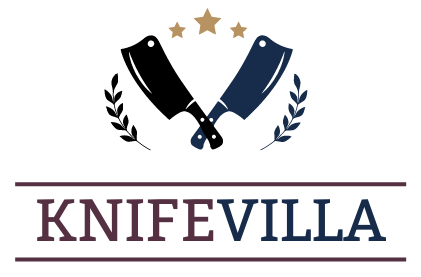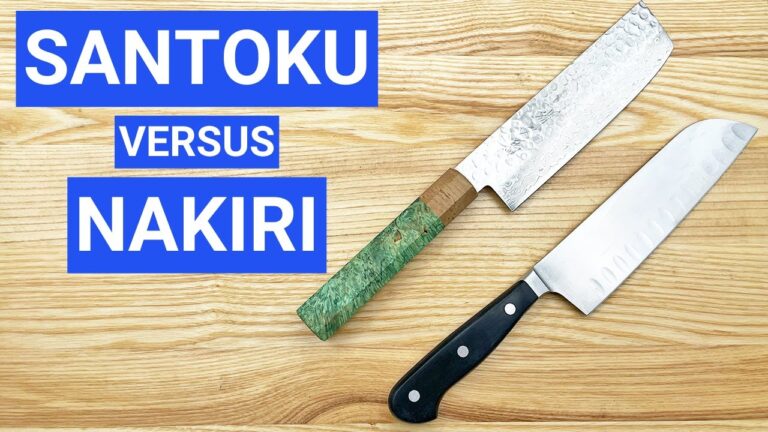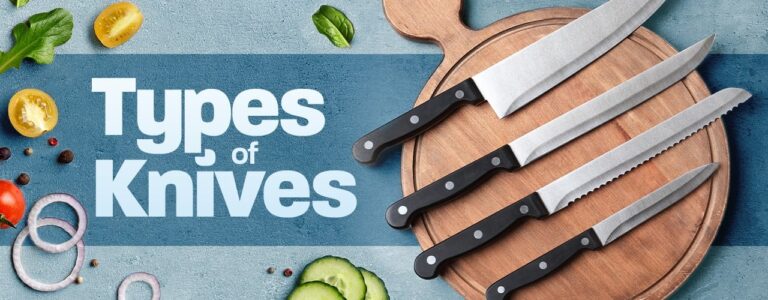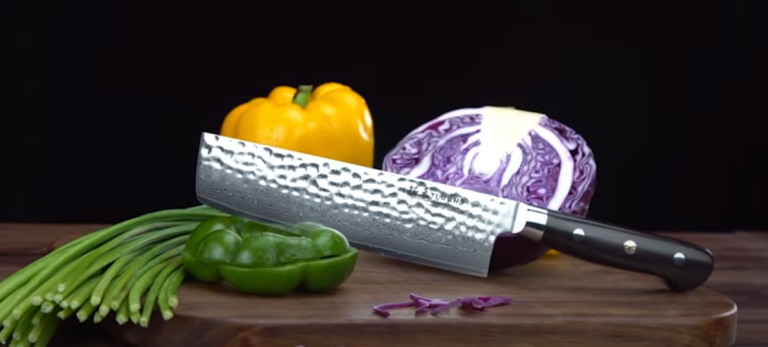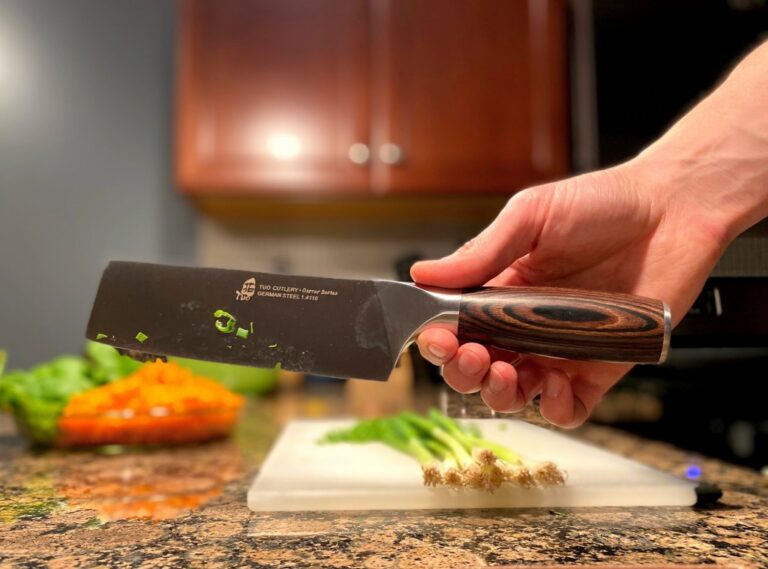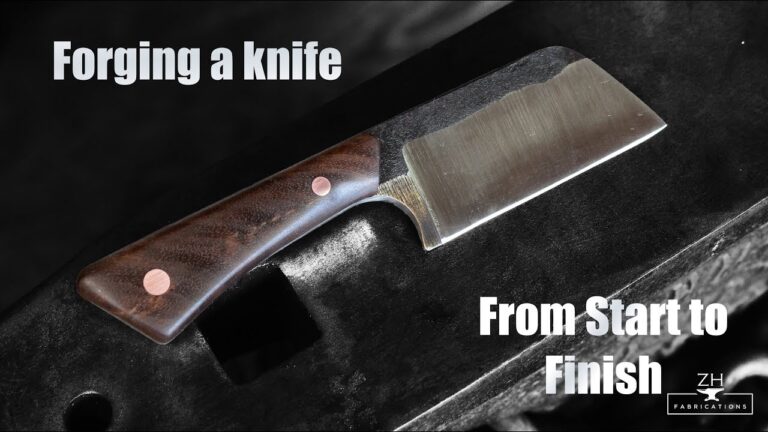Best Santoku Knives of 2023(Reviews)
The Santoku is a western Japanese-style multi-purpose knife. It is used for dicing, slicing, and chopping meat, fish, and vegetables. Many types of santoku knives are available in the market depending upon their features and uses. They are single bevels meaning that the blade tapers to the edge on only one side. We reviewed the best Santoku knives for your kitchen in this article. It will help you to decide which one is suitable for you.
1. Santoku Wusthof Classic Hollow Edge Santoku Knife 4182, 5″: Best Mid-Sized
Santoku Wusthof Classic Hollow Edge Santoku Knife 4182, 5 is made in Germany with a traditional look. The handle is made from high-quality material and is triple riveted with a comfortable grip. These knives are shorter than other santoku knives and are well suited for people who prefer shorter blades due to their small hands. Full tang construction can hold hands with more security. The blade remains sharp for a long time and no need to sharpen it again and again. The presence of Granton on the edge prevents food from sticking during slicing, dicing, and chopping. The full bolster protects the user’s hand.
Key Specifications:
- Full tang construction and versatility.
- Sharp.
- Triple-rivet handle.
- Susceptible to stains and scratches.
2. Zwilling JA Henckels Pro 7″ Rocking Santoku Knife:Best Hybrid
This santoku knife is made from German stainless steel and is a combination of western and traditional styles. The blade is curved for good rocking action. The handle is made up of Stainless steel and is ergonomic. It provides balance and control. Although it is dishwasher safe, hand washing is still suggested.
Key Specifications
- Extra sharpness.
- Ergonomic handle.
- Heavy in weight.
3. Henckels Zwilling Twin Signature Hollow Edge Santoku Knife: Best Overall
Zwilling Twin Signature 7-Inch Hollow Edge Santoku made in Germany is well known and best rated for its sharpness and lightweight. The blade is ice-hardened stamped rather than forged. It is a good addition to any cook’s kitchen due to balance and weight. It has a triple-riveted handle and full tang construction. The handle is very comfortable and perfect for new cooks. The blade has razor sharp edge good for chopping vegetables, cutting fish and meat, cutting tomatoes, and cutting slices of roast.
Key Specifications
- Rocking cuts due to curved blades.
- Sharp.
- Lightweight.
- Not dishwasher safe.
- Stamped blade.
4. Mercer Culinary Genesis Forged Santoku Knife, 7-Inch (M20707): Budget Friendly
This knife is one of my favorite choices due to its excellent performance and affordable range. The handle is made from Santoprene which is a composite of plastic and rubber. It provides a non-slip and easy grip. The dimples prevent friction during slicing. This knife is the best choice for those who are beginners and can use it as a trial.
Key Specifications
- Budget-friendly.
- Non-slip grip even with wet hands.
- Hand washing is recommended.
5. MAC Knife MSK-65 Professional Hollow Edge Santoku Knife: The Best Choice
MAC’s MSK-65 Professional Hollow Edge santoku is a traditional western knife made in Japan. It is used for cutting tomato slices, gliding through dense carrots, butchering the chicken, and filleting the fish. The dimples or Granton are present on this knife which prevent friction during slicing. It also prevents the sticking of food to the blade. The handle is made from a highly durable material pakkawood which provides an easy grip. It is well suited both for right and left-handed people.
Key Specifications
- Comfortable in use.
- Durable.
- No sticking of food.
- Hand washing is recommended.
6. Santoku Oxo 23081 Good Grips Mini Santoku Knife: Best Mini
This type of santoku knife is used for performing small tasks. It is best used for slicing and chopping and has some resemblance to a utility and paring knife. The handle provides a comfortable grip. The blade is made from stainless steel with high sharpness. The attractive feature of this knife is that you do not need to sharpen it frequently.
Key Specifications
- Easy grip.
- Good for small tasks.
- Easy to re-sharpen.
- Versatility.
- Flimsy blade.
7. Sabatier Forged Stainless Steel Santoku Knife: Best Self-Sharpening
As the name indicates this knife can be sharpened on its own when you remove or insert it into to sheath. The handle is ergonomic and made from durable and high-quality material. The blade has a high cutting angle. This knife can withstand for a long time. Proper care is needed for its maintenance. You must dry it immediately after washing it to avoid rust.
7. Sabatier Forged Stainless Steel Santoku Knife
Key Specifications
- Highly durable.
- Sharpening sheath availability.
- Good balance and control.
- Not rust resistant.
- Hand washing is recommended.
8. Victorinox Santoku Starter Set: Excellent Option for Beginners
This knife is made from stainless steel carbon and is known for its versatility. Its outstanding property is its razor-sharp edge. The blade is delicate and thin which can perform functions precisely. Its long blade can cut larger vegetables too. The handle is made from plastic and provides easy grip and balance. This is the best choice for those who are looking for a high-utility knife.
Key Specifications
- It is very sharp.
- Easy grip.
- Versatility.
- The handle is made from plastic.
- The blade is delicate.
9. Zelite Infinity Alpha-Royal Series Santoku Knife 7 Inch: Best High-End
High-End Zelite Infinity Alpha-Royal Series Santoku Knife 7 Inch is constructed from Japanese carbon stainless steel. It is used for slicing of herbs, greens, radishes, tomatoes, and nuts due to its razor-sharp edge and amazing performance. The blade is curved with the best functionality. The presence of the Damascus pattern on the blade makes it unique and extraordinary than other knives. It has full tang construction and hollow ground. The handle is ergonomic and triple riveted. The presence of a bolster makes it easy to hold and provides a good balance. The thing I liked about it is that it comes with a box and you can offer it as a gift.
Key Specifications
- Attractive and blade.
- Perform kitchen tasks efficiently.
- Available in gift packaging.
- Heavy for some people.
- Frequent sharpening is needed.
Buying Guide For Best Santoku Knife
1. Blade Length
A blade size of 7 inches is preferred for cutting while for cutting smaller vegetables 5-inch blade is suitable. Santoku knives are usually tall. While selecting the size of the knife other factors like food size and cutting surface should also be considered.
2. Blade Thickness
Santoku knives have thinner blades because they are used for delicate cuts. In order to get precise cutting blade should be thin.
3. Strength
The best santoku knives are sturdy, durable, versatile, and inflexible. You should avoid knives that are made from metal. Good quality knives are made from carbon or stainless steel.
4. Handle
A triple riveted handle is responsible for the durability of these knives. You can select a knife having full tang construction because it prevents the blade from snapping off.
5. Tall Blade
As I mentioned that many santoku knives are tall with a big surface area. This provides a balance while slicing and cutting the food. You can also transfer food ingredients to the pan easily it.
6. Granton Edges
Many santoku knives have dimples on the blade known as Granton. These Granton prevent friction while slicing the food. They also keep away the sticking of food to the blade. The risk of slipping of hand is also reduced due to these dimples.
Frequently Asked Questions
1. What are the uses of a santoku knife?
Santoku knives are best for slicing, filleting fish, dicing, and chopping with high precision. Due to its versatility, it can be used for many purposes.
2. Is Santoku Knife different from a chef’s knife?
Santoku Knives are sharper with taller blades and do not have a rocking motion. The chef knife on the other hand has a curved shape blade and is used for chopping with a rocking motion.
3. What are the functions of Granton on a santoku knife?
The dimples or Granton are helpful in reducing friction during slicing. They also prevent food from sticking to the blade.
4. Can a santoku knife be used to cut meat?
Yes, the Santoku knife can be used to cut meat.
5. How santoku knife is different from a Nakiri knife?
A Nakiri knife is a vegetable knife used for slicing and cutting vegetables or meat. Its blade is rectangular in shape. While the Santoku knife is used for cutting, slicing, dicing meat, and chopping. The blade is flat. Read more about Nakiri VS Santoku Knife
6. Can I sharpen a santoku knife?
Yes, the Santoku knife can be sharpened by using a whetstone and sharpener. Honing the rod should be avoided to sharpen it.
7. Why do you need a santoku knife?
The Santoku knife is the best choice for the kitchen due to its lightweight and versatility. It shorter and sharp blade for precise cutting.
Final Verdict: Which Santoku knife Is Best For You
Although the selection of the best knife is a highly personal decision, there are some basic preferences and needs we can consider. Before selecting the best santoku knife make sure it is sharp. The sharpness of a knife is one of the major features of the best knife. If you are looking for the best self-sharpening Santoku knife then Sabatier Forged Stainless Steel Santoku Knife is a good option. Victorinox Santoku Starter Set is an excellent option for beginners. On the other hand, if your preference is budget friendly then go with Mercer Culinary Genesis Forged Santoku Knife, 7-Inch (M20707).
